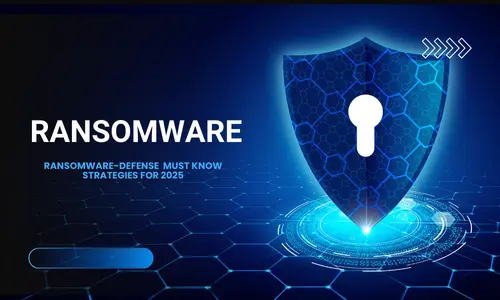Ransomware Defense: Must-Know Strategies for 2025

The Rise of DevSecOps: How to Secure Your Software Pipeline in 2025
April 10, 2025
The Power of Voice Search Optimization: SEO Strategies for 2025
April 12, 2025In an era where cyber threats evolve at breakneck speed, ransomware defense stands as a critical pillar for businesses, individuals, and organizations worldwide. Ransomware attacks, which lock critical data and demand hefty payments for release, have grown in sophistication, targeting everyone from small startups to global enterprises. As we step into 2025, understanding how to protect against these threats is no longer optional—it’s a necessity. This article explores actionable, forward-thinking strategies to fortify your defenses and keep your digital assets safe.
Why Ransomware Defense Matters in 2025
Ransomware has transformed from a niche cybercrime into a global epidemic. In 2024 alone, attacks cost businesses billions, with downtime, recovery, and ransom payments taking a heavy toll. Hackers now leverage advanced tactics like double extortion—encrypting data and threatening to leak it publicly—making robust ransomware defense essential. Beyond financial losses, a successful attack can erode trust, damage reputations, and disrupt operations for weeks or even months.
The good news? With the right strategies, you can significantly reduce your risk. From leveraging cutting-edge technology to fostering a security-first culture, here’s how to stay ahead of ransomware in 2025.
Understanding the Ransomware Landscape
Before diving into ransomware defense strategies, it’s crucial to understand the current threat landscape. Hackers are no longer relying on basic phishing emails. They’re using artificial intelligence (AI) to craft convincing scams, exploiting software vulnerabilities, and targeting poorly secured cloud environments. Small businesses, healthcare providers, and even government agencies remain prime targets due to their often-limited cybersecurity budgets.
The rise of Ransomware-as-a-Service (RaaS) has also lowered the barrier to entry for cybercriminals, enabling less-skilled attackers to launch sophisticated campaigns. This democratization of cybercrime means no one is safe—making proactive defense more important than ever.
Core Strategies for Effective Ransomware Defense
Building a resilient ransomware defense requires a multi-layered approach. Below are the must-know strategies to protect your organization in 2025.
Prioritize Regular Data Backups
A robust backup system is your first line of ransomware defense. If attackers lock your files, a recent, secure backup allows you to restore operations without paying a ransom. Follow the 3-2-1 backup rule: keep three copies of your data, store two on different media types, and one offsite or in the cloud. Ensure backups are encrypted and tested regularly to confirm they’re usable during a crisis.
Cloud-based backup solutions with immutable storage—where data can’t be altered or deleted—are particularly effective against ransomware. Schedule automated backups to minimize human error and keep recovery times short.
Patch and Update Systems Relentlessly
Unpatched software is a hacker’s playground. Many ransomware attacks exploit known vulnerabilities that could’ve been fixed with timely updates. In 2025, prioritize automated patch management to keep operating systems, applications, and firmware current. Don’t overlook third-party software, which is often a weak link.
Enable automatic updates where possible, and for critical systems, test patches in a sandbox environment before deployment. A proactive patching strategy is a cornerstone of ransomware defense that can’t be ignored.
Deploy Advanced Endpoint Protection
Traditional antivirus software is no longer enough. Modern ransomware defense demands endpoint detection and response (EDR) tools that monitor devices in real-time, detect suspicious behavior, and block threats before they spread. Look for solutions with AI-driven analytics to identify zero-day attacks and ransomware variants.
In 2025, integrating EDR with extended detection and response (XDR) platforms can provide broader visibility across your network, cloud, and endpoints, creating a unified defense system.
Strengthening Your Human Firewall for Ransomware Defense
Technology alone can’t stop ransomware—your people play a critical role. Human error, like clicking phishing links or using weak passwords, remains a top entry point for attacks. Here’s how to empower your team.
Invest in Ongoing Cybersecurity Training
Regular training is a vital component of ransomware defense. Educate employees on spotting phishing emails, recognizing social engineering tactics, and following secure password practices. Use simulated phishing campaigns to test their vigilance and reinforce lessons.
In 2025, training should extend beyond basics. Teach staff about emerging threats like AI-generated deepfake scams or business email compromise (BEC) attacks. A well-informed team is your strongest asset.
Enforce Least Privilege Access
Limit access to sensitive systems and data to reduce the blast radius of a ransomware attack. The principle of least privilege ensures employees only have the permissions they need to do their jobs. Combine this with multi-factor authentication (MFA) to add an extra layer of security.
Regularly audit access controls to revoke unnecessary permissions, especially for former employees or contractors. This simple step can significantly bolster your ransomware defense.
Leveraging Technology for Ransomware Defense
As ransomware evolves, so must your tech stack. Here are the tools and approaches shaping ransomware defense in 2025.
Embrace Zero Trust Architecture
Zero trust assumes no user or device is inherently trustworthy, even inside your network. By verifying every access request, zero trust minimizes the risk of ransomware spreading laterally. Implement strong identity verification, segment networks, and monitor traffic for anomalies.
In 2025, zero trust is no longer a buzzword—it’s a necessity for comprehensive ransomware defense. Start small with critical systems and scale over time.
Use AI and Machine Learning Proactively
AI isn’t just for hackers. Organizations can harness machine learning to predict and prevent ransomware attacks. AI-driven tools analyze patterns, detect anomalies, and respond to threats faster than humans can. For example, behavioral analytics can flag unusual file encryption activity, halting ransomware in its tracks.
Choose platforms that integrate AI with your existing security tools for a seamless ransomware defense strategy.
Preparing for the Worst: Incident Response Planning
Even with the best ransomware defense, breaches can happen. A well-crafted incident response plan ensures you’re ready to act swiftly.
Develop and Test Your Response Plan
Your incident response plan should outline clear steps for identifying, containing, and recovering from a ransomware attack. Assign roles to team members, establish communication protocols, and document recovery procedures. Regularly test the plan through tabletop exercises to uncover gaps.
In 2025, include scenarios for double extortion and supply chain attacks, which are increasingly common. A prepared organization can minimize damage and avoid paying ransoms.
Engage Cyber Insurance Wisely
Cyber insurance can offset the financial impact of a ransomware attack, covering costs like recovery, legal fees, and even ransom payments in some cases. However, insurers are tightening requirements, so ensure your ransomware defense measures—like MFA and backups—meet their standards.
Review policies annually to confirm coverage aligns with evolving threats. Insurance is a safety net, not a substitute for proactive defense.
Staying Ahead of Ransomware Trends
Ransomware tactics shift constantly, and 2025 will bring new challenges. Expect attackers to target Internet of Things (IoT) devices, exploit 5G vulnerabilities, and weaponize generative AI for more convincing scams. To maintain effective ransomware defense, stay informed through threat intelligence feeds, industry reports, and cybersecurity communities.
Conclusion: Building a Resilient Future
Ransomware isn’t going away, but with the right strategies, you can protect your organization from its devastating effects. From robust backups and zero trust to employee training and AI-driven tools, a multi-layered ransomware defense is your best weapon in 2025. Start small, prioritize high-impact measures, and commit to continuous improvement.


